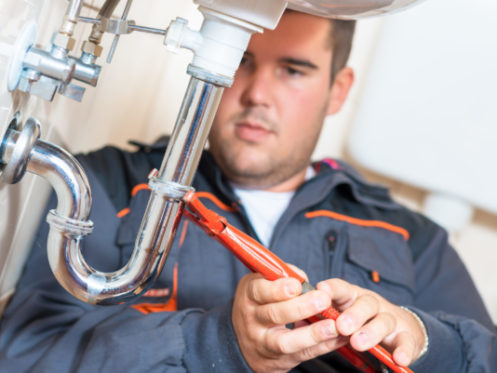There are a few different things that can cause backflow in plumbing, but one of the more common reasons is when you have an improper or blocked vent. This prevents air from being vented out of your pipes. Instead, the air and water pressure pushes the water backward, causing a vacuum effect that pulls more water through your drain pipes into your home. This may also cause water damage to your home.
How do you know if you are experiencing backflow? You will notice leaks, reduced water pressure, discolored water, odd smell, visible particles and slow drainage. If any of these occur, you may have backflow in your plumbing.
There are two types of backflow: back pressure and back-siphonage. Back pressure occurs when water pressure from a non-potable source exceeds your water supply. This causes the flow to reverse. Back siphonage occurs when there is a loss of pressure in your supply line that causes contamination to be sucked in.
A Broken Water Main
Since backflow happens when the wrong water pressure is introduced into a pipe by making its way into your water main, it’s important to note that a broken water main can directly cause backflow. If you detect a broken water main in your house or your street, seek professional help. Once the break happens and water begins to flow back into your home, the damage can be extensive.
Plumbing Overhauling
If your home’s plumbing is old, it may be time to overhaul your plumbing. Overhauling is a standard method of ensuring that your water supply and drain pipes are safe for today’s technology and the dangers of corrosion-free water supply. This is done by replacing the entire system with new construction for better performance. When this process is complete, you can enjoy clean, safe water throughout your home.
However, some overhauls require draining of the building’s water supply. This is done to ensure that everyone in the home has better access to water. In some situations, there can be a temporary backflow that an experienced plumber can prevent.
Emergency Water Consumption
Sometimes, backflow may occur when there is a sudden surge in water consumption. This might be because firefighters use an enormous amount of water in your neighborhood.
Long Power Breakdown
A power outage can cause a backflow in your plumbing as well. This can be dangerous because the water coming back into the home could be contaminated, and if there is a loss of pressure, this can cause back-siphonage.
Old Water Pipe
Old water pipes corrode and break, causing leakage and allowing backflow to enter your home. Over time, the pipe will deteriorate and cause backflow in some ways. When this happens, you will have low pressure, discolored toilet water, and sediment buildup in the piping underneath your home. To maintain a clean and safe water supply, you must regularly inspect your plumbing. If you suspect something is wrong with your plumbing, call a professional for an evaluation.
Long-Term Clog
Long-term clogs in your pipes can also cause backflow. This is because water cannot flow properly through your pipes when blocked. This results in the pressure of the water building, and the backflow occurs.
Clogs can occur due to hard-water deposits or mineral buildup inside pipes or fixtures that can be difficult to remove. This can result in backflow into your home’s plumbing system and clogs on sinks and bathtubs.
Broken Water Valve
And, of course, a broken water valve can cause backflow in your home. This is because the valve regulates the flow of water to your home. A broken valve will cause water to flow backward into your plumbing and bathing area.
Bad Plumbing
Inadequate or inefficient plumbing can also cause backflow. This is because the plumbing does not properly eliminate the water from your home. Instead, it causes the water to flow backward, causing several problems with your plumbing. Inspect your plumbing regularly when you want to ensure that its working correctly and that you have a safe and clean water supply. Check for other issues as well.
For example, the lack of a plumbing vent pipe can be detrimental because it is supposed to regulate the air in your system. If you do not have a vent pipe, there is a possibility that the water can cause backflow into your home through fittings and connections.
In-House Pressure Difference
A home appliance that uses water generates more pressure than the water supply, which can cause a backflow in the plumbing. This is because the water will be forced back into your pipes, which can cause serious problems. For instance, using a pressure washer to clean your driveway may cause the water to flow back into the plumbing, causing damage to your home.
Drain Backups
If you are experiencing issues with your drain system, there is a chance that back pressure could occur. This is when the pipes get clogged and cause backwash into your bathtub or sink, resulting in discoloration of the water within it. This will create a foul odor from your drain and slow drainage from your tub or sink.
Lack of Service and Maintenance
When you don’t service your plumbing correctly or perform routine maintenance, this can result in backflow problems. It is crucial to make sure that you check for these issues and correct them as soon as possible. This can help prevent damage to your home and other problems. An expert can also prevent backflow by doing the following.
Installing a Backflow Preventer Valve
Most of these valves have a passage going back into the line to ensure that water can flow in the proper direction. This backflow valve usually has a check valve to prevent water flowing backward. It is typically installed near the point where water enters your home and should be sized appropriately. The installation size should be based on how much water your home uses and how much pressure there is behind it.
Creating an Air Gap
You will want to create an air gap between the street and the home piping. This prevents backflow by providing a cushion of air that prevents water from flowing backward. It also helps prevent bacteria and pipe corrosion from entering your home’s plumbing system.
It’s important to note that you should periodically have a plumber look over your plumbing and ensure that anything in your system isn’t clogged or causing backflow. A plumber can check out your valves and water lines and the other components of your plumbing system. It’s best to have an annual check-in to know what your system looks like and where any blockage may be. Summit Heating & A/C in Denver, CO will help install and maintain your plumbing system.
Backflow is a severe issue for homeowners and property managers. If you suspect your home’s plumbing system is experiencing backflow, you should immediately call a professional plumber for repairs. We offer heating, air conditioning, air quality and plumbing services. Contact Summit Heating & A/C today to learn more.


